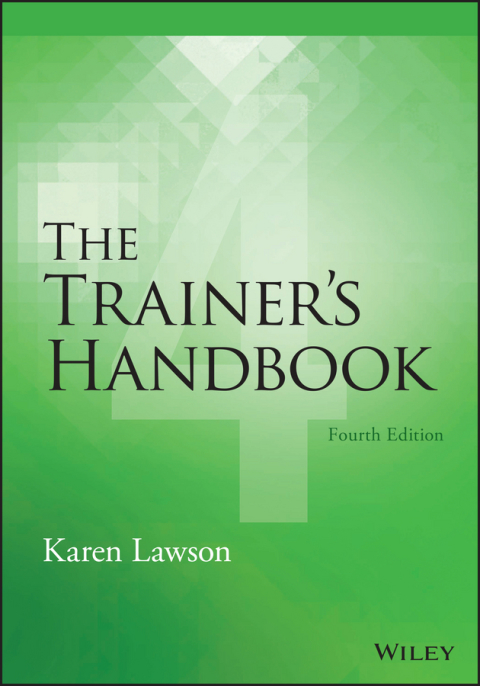Description
Efnisyfirlit
- Title Page
- Copyright
- Contents
- List of Tables, Exhibits, and Figures
- Acknowledgments
- Preface
- Part I Training Fundamentals
- Chapter 1 Assessing Needs
- Understanding Needs Assessment
- Needs-Assessment Process
- How to Conduct a Needs Assessment
- Developing an Action Plan
- Assessing Participants’ Knowledge, Attitudes, Skills
- Key Points
- Chapter 2 Understanding Adult Learners
- Andragogical versus Pedagogical Model
- How and Why People Learn
- Learning Styles
- Application of Learning Principles
- Key Points
- Chapter 3 Training Styles
- Trainer Characteristics and Competencies
- Training Style
- Learner-Centered versus Information-Centered
- Key Elements of a Trainer’s Style
- Key Points
- Chapter 4 Understanding Today’s Learner
- The Changing Training Environment
- Self-Awareness
- Diversity Issues
- Key Points
- Chapter 5 Writing Instructional Objectives
- What Are Learning Objectives?
- Writing Learning Objectives
- Key Points
- Chapter 6 Writing an Instructional Plan
- Instructional Plan Overview
- Time Needed to Develop a Training Program
- Cost Considerations
- Major Components of Design
- Creating a Design Matrix
- Creating a Detailed Instructional Plan
- Components of an Instructional Plan
- Instructional Methods
- Developing Materials
- Key Points
- Chapter 7 Selecting, Designing, and Developing Active-Training Methods
- The Case for Active Training
- Cooperative Learning
- Creating an Active-Learning Environment
- Designing Active-Training Activities
- Common Methods and Materials
- Experiential Learning Activities
- Key Points
- Chapter 8 Delivering Training
- Creating a Positive Learning Environment
- Experiential Learning Cycle
- Tips for Using Specific Methods
- Improving Platform Presence
- Key Points
- Chapter 9 Using Visual Aids
- Retention Rate in Visual Learning
- Reasons to Use Visual Aids
- Guidelines for Using Slides
- Using Flip Charts
- Using Videos and Video Clips
- Key Points
- Chapter 10 Working with Groups
- The Trainer as Facilitator
- Ways to Encourage Participation
- The Art of Asking Questions
- Responding to Questions
- Scaling the Wall of Resistance
- Problem Situations
- Key Points
- Chapter 11 Using Creativity
- Creativity with Small Groups
- Props and Other Theatrical Techniques
- Using Games
- Creative Closings
- Key Points
- Chapter 12 Evaluating Training
- Evaluation Basics
- Four-Level Model for Training Evaluation
- Participant Evaluation and Accountability for e-Learning
- Accountability for Training
- Significance of the Evaluation Process
- Key Points
- Part II Special Training Considerations
- Chapter 13 Training across Cultures
- Globalization of Businesses and People
- Culture and Cultural Dimensions
- Becoming Culturally Intelligent
- Practical Application
- Key Points
- Chapter 14 Storytelling as a Training Technique
- The Value of Storytelling
- Types of Stories
- Telling Personal Stories
- Capturing Your Personal Stories
- How to Tell Your Story
- Key Points
- Chapter 15 Using Technology in Training
- Workplace Trends
- Advantages/Benefits of Distance Learning
- Disadvantages/Drawbacks to Distance Learning
- Types of Distance Learning
- Guidelines for Designing Distance Learning
- Designing and Developing Activities
- Delivering Content and Activities
- Key Points
- Chapter 16 Training On the Job
- The Need for Structured On-the-Job Training
- Selecting the Trainer
- Developing an Instructional Plan
- On-the-Job Training Model
- Evaluating On-the-Job Training
- Key Points
- Chapter 17 Training During Tough Times
- Prove the Value of Training
- Methods to Stretch Training Dollars
- Technology-Based Delivery Methods
- Just-in-Time Materials
- Key Points
- Chapter 18 The Business of Consulting: Internal and External
- The Changing Role of the Trainer
- The Client-Consultant Relationship
- Developing a Proposal
- Setting Clear Expectations
- Selecting an External Consultant
- After the Project
- Key Points
- Appendix A: Answers to Exercises
- Appendix B: Recommended Resources
- Appendix C: Criteria for Selecting Packaged Programs
- References
- Index
- About the Author
- EULA







Reviews
There are no reviews yet.